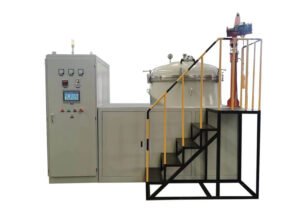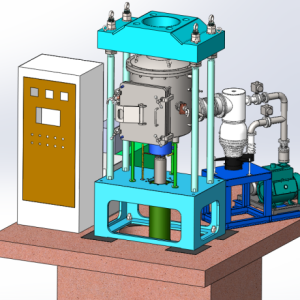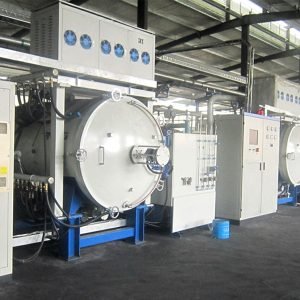Author: Yuan Mingjian, Zigong Cemented Carbide Co., Ltd.
Use three dewaxing methods by dewaxing furnace.
Three dewxing methods of hydrogen, nitrogen, and vacuum to remove the cemented carbide forming agent in the dewaxing furnace respectively. Then detact and analyze the vacuum sintering and the sintered cemented carbide. It is found that saturated tungsten carbide can be used in hydrogen dewaxing vacuum sintering process.
In the vacuum dewaxing stage, the speed of vacuum radiation heat transfer could be faster, which lags behind the design of the dewaxing program. The dewaxing speed is slow, resulting in not wholly remove the paraffin wax in the product in the dewaxing stage and remains in the pressed product. After sintering, the product is easy to carburize. In order to make the sintered product non-carburized, it is necessary to reduce the total carbon of tungsten carbide to meet the quality requirements of cemented carbide.
Cemented carbide and coarse-grained cemented carbide for mining tools are suitable for dewaxing in a hydrogen atmosphere. The dewaxing is more thorough and the time is shorter. At the same time, hydrogen also has good thermal conductivity and reducibility.
In order to choose the appropriate dewaxing process to make the cemented carbide achieve the best performance after sintering the compact. Select three processes of nitrogen dewaxing, hydrogen dewaxing and vacuum dewaxing for comparative experiments. After comparison, select the hydrogen dewaxing vacuum sintering and hydrogen dewaxing pressure sintering processes as the research direction.
Discuss the influence of various process parameters on the dewaxing effect by dewaxing furnace through experiments.
Test method
1. Experimental raw materials
Use the tungsten carbide with unsaturated carbon and saturated carbon, and the Table 1 shows the technical indicators. Table 2 shows the main properties of the cobalt powder used in the experiment.
Table 1 Technical indicators of unsaturated carbon and saturated carbon tungsten carbide
| WC samples | Fsss(μm) | TC (%) | Carbide Carbon (%) | Impurity Content (≤%) | Cr (%) | |||
| Free Carbon | Fe | Cl | O | |||||
| WCTD 1 | 14.0 | 6.03 | 6.00 | 0.03 | 0.05 | 0.04 | 0.05 | – |
| WCTD 2 | 14.3 | 6.05 | 6.02 | 0.03 | 0.05 | 0.04 | 0.05 | – |
| WCTG 1 | 15.1 | 6.12 | 6.09 | 0.03 | 0.05 | 0.04 | 0.05 | – |
| WCTG 2 | 14.8 | 6.13 | 6.10 | 0.03 | 0.05 | 0.04 | 0.05 | – |
| WCTG 3 | 15.4 | 6.15 | 6.11 | 0.04 | 0.05 | 0.04 | 0.05 | – |
| WCTG 4 | 15.2 | 6.18 | 6.11 | 0.07 | 0.05 | 0.04 | 0.05 | – |
Table 2 Main properties of cobalt powder used in experiments
| Name | Fsss(μm) | w(Co+Ni) | w(O) | w(C) | w(Ni) | w(Fe) | BET (m2/g) |
| Co Powder | 1.20 | ≥98.5 | 0.60 | 0.03 | 0.01 | 0.008 | 1.16 |
2. Experimental process by dewaxing furnace
Prepare a mining mixture with a cobalt content of about 11%. Use hexane as the wet grinding medium, and add 2.0% paraffin and 0.1% additives to the wet mill. According to the mass ball milling process and technical requirements of this brand, after ball milling, the obtained slurry is spray dried to obtain spray paraffin material. A φ12×16 button was pressed with a DORST press (diameter φ=12 mm, height H = 16 mm, spherical cap radius SR = 6.5 mm, bottom chamfer r = 1.5 mm, green compact weight 23.4 g). Then put the compacted buttons into the CHINACNEQUIPS dewaxing furnace for nitrogen dewaxing, hydrogen dewaxing, and vacuum dewaxing. Afterward, they were all placed in a vacuum sintering furnace for vacuum sintering.
Comparison of three dewaxing methods under the same sintering procedure. Use three dewaxing methods of hydrogen, nitrogen and vacuum for dewaxing. After dewaxing, place them in a vacuum sintering furnace for vacuum sintering at a temperature of 1420 °C. Sent the carbide samples for analysis and testing. And comparison and analysis the selected dewaxing method based on the test results.
Experimental results and discussion
Comparison of dewaxing methods
The Table 3 shows the main process parameters and technical conditions of dewaxing and vacuum sintering using three different dewaxing methods of hydrogen, nitrogen and vacuum. The Table 4 shows the analysis results of the alloy after sintering. The Figures 1 to 3 shows the metallographic photos respectively.
Table 3 Main process parameters and technical conditions of dewaxing vacuum sintering in different dewaxing methods
| Serials | Debinding Method | Debinding Temperature ℃ | Debinding holding time (min) | Sintering Temperature ℃ | Total carbon content (wt%) |
| 1# | H2 | 380 | 90 | 1420 | 6.03 |
| 2# | N2 | 380 | 90 | 1420 | 6.03 |
| 3# | Vacuum | 380 | 90 | 1420 | 6.03 |
Table 4 Analysis and detection of cemented carbide obtained by dewaxing and sintering in different dewaxing methods
| Serials | Relative magnetic saturation | Decarburization / Carburization | Total carbon content (wt%) | Converted to the total carbon of tungsten carbide (wt%) |
| 1# | 68.9 | E50 (Decarburization) | 5.18 | 5.84 |
| 68.3 | E50 (Decarburization) | |||
| 2# | 100.1 | C08 (Carburization) | 5.60 | 6.34 |
| 100.2 | C08 (Carburization) | |||
| 3# | 99.4 | C00 (Normality) | 5.44 | 6.12 |
| 98.2 | C00 (Normality) |

Fig.1 Metallographic photographs of the cemented carbide after hydrogen dewaxing and vacuum sintering

Fig. 2 Metallographic photographs of the cemented carbide after nitrogen dewaxing and vacuum sintering

Fig. 3 Metallographic photos of the cemented carbide after vacuum dewaxing and vacuum sintering
Detact and analyze the vacuum sintering and the sintered cemented carbide.
The test data in Table 4 shows that the total carbon content in 1# cemented carbide is converted into the total carbon content of tungsten carbide in cemented carbide is 5.84%. Less than the total carbon content of the raw material WC, that is, the carbon content is reduced.
Figure 1 metallographic photograph shows cemented decarburization. The total carbon content in the 2# alloy is 6.34% after conversion. Which is 6.03% greater than the total carbon content of the raw material WC. That is, the carbon content has increased. From the metallographic photos in Figure 2, we can see that the cemented carbide is severely carburized after vacuum sintering. The total carbon content in the 3# alloy is 6.12% after conversion. Which is greater than the total carbon content of the raw material WC. The metallographic photos of Figure 3 show that the metallographic phase of the alloy is normal.
In summary, the cemented carbide obtained after vacuum sintering by hydrogen dewaxing is seriously decarburized. The cemented carbide obtained after vacuum sintering by nitrogen dewaxing is severely carburized. The microstructure of the cemented carbide obtained after vacuum dewaxing and vacuum sintering is normal.
Serious decarburization occurs in the cemented carbide after the hydrogen dewaxing furnace and vacuum sintering furnace process.
In the hydrogen dewaxing mode, as the temperature rises, the hydrogen and the carbon in the semi-finished product reduce the metal oxide, see the reaction formula (1), (2). The combined carbon of WC also reacts with hydrogen and cobalt and tungsten suboxides, resulting in a reduction of C. See equations 3, 4, and 5.
CoO+H2→Co+H20 (1)
CoO+C→Co+CO (2)
WC+2H2→W+CH4 (3)
2WC+2CoO→W2C+CO2+2Co (4)
2WC+WO2→W2C+CO2+W (5)
Under the technical conditions of this process, hydrogen not only removes all the paraffin in the cemented carbide compact. Moreover, it takes away the carbon in the raw material WC. The calculated carbon content of WC in cemented carbide is lower than that of raw WC.
Severely carburization occurs in the cemented carbide after the nitrogen dewaxing furnace and vacuum sintering furnace process.
In the nitrogen dewaxing mode, during the process of dewaxing and sintering the compact into cemented carbide, as the temperature rises, the nitrogen does not react with the metal oxide in the semi-finished product. Only the carbon in the semi-finished product reacts with the metal oxide. At the same time, since the thermal conductivity of nitrogen is lower than that of hydrogen. At this heating rate to the dewaxing holding temperature of 380 °C, after 90 minutes of holding. It doesn’t completely remove the paraffin. As the sintering temperature increases beyond 400 °C, the paraffin cracks to produce free carbon and deposits in the alloy. The reactions of (6) and (7) occur during the sintering process:
CH4 → C+H2 (6)
W2C+C→2WC (7)
The carbon after the reaction still exceeds the theoretical carbon content of the two-phase region of the alloy. Therefore, under this nitrogen dewaxing method, carburization occurs in the cemented carbide.
The cemented carbide is normal after the hydrogen dewaxing furnace and vacuum sintering furnace process.
Under the condition of vacuum dewaxing, during the process of dewaxing and sintering the green compact into a cemented carbide, as the temperature rises, evaporated and pumped away the paraffin.
At the same time, due to the heat transfer by radiation in the vacuum state, it doesn’t completely come out the paraffin wax after keeping at 380°C for 90 minutes. With the increase of the sintering temperature, when the temperature of the compact exceeds 400 °C, the paraffin cracks to produce free carbon and deposits in the alloy. The reactions of (6) and (7) occur during sintering. After the reaction the carbon reaches the theoretical carbon content of the two-phase region of the cemented carbide. The cemented carbide structure is a two-phase structure that does not carburize or decarburize.
Therefore, the effect of hydrogen dewaxing is better than that of vacuum dewaxing, and the effect of vacuum dewaxing is better than that of nitrogen dewaxing.
From the carbon content of the cemented carbide after sintering, the carbon content of the alloy after hydrogen dewaxing and sintering is the lowest. In order to increase the total carbon of raw material WC, use the tungsten carbide with saturated carbon content to produce cemented carbide. Use the hydrogen dewaxing to realize the production and quality control of cemented carbide.
Conclusion on the three dewaxing methods effect
- Under the test conditions, the effect of hydrogen dewaxing is better than that of vacuum dewaxing, and the effect of vacuum dewaxing is better than that of nitrogen dewaxing.
- At a temperature of 200-400 °C, with the extension of the dewaxing holding time and the increase of the dewaxing holding temperature, the better the dewaxing effect in the green compact.
- Use WC-Co cemented carbide with a saturated carbon content of 6.13% as a raw material, 2.0% paraffin wax as a molding agent, and 11% cobalt. In the CHINAEQUIPS dewaxing furnace, the furnace load is 6 kg, the hydrogen dewaxing holding temperature is 360 ℃, the holding time is 120 min, and the appropriate heating rate and hydrogen flow rate can produce qualified cemented carbide.











